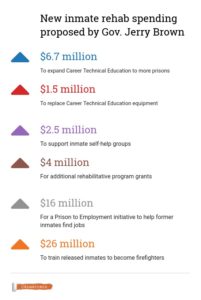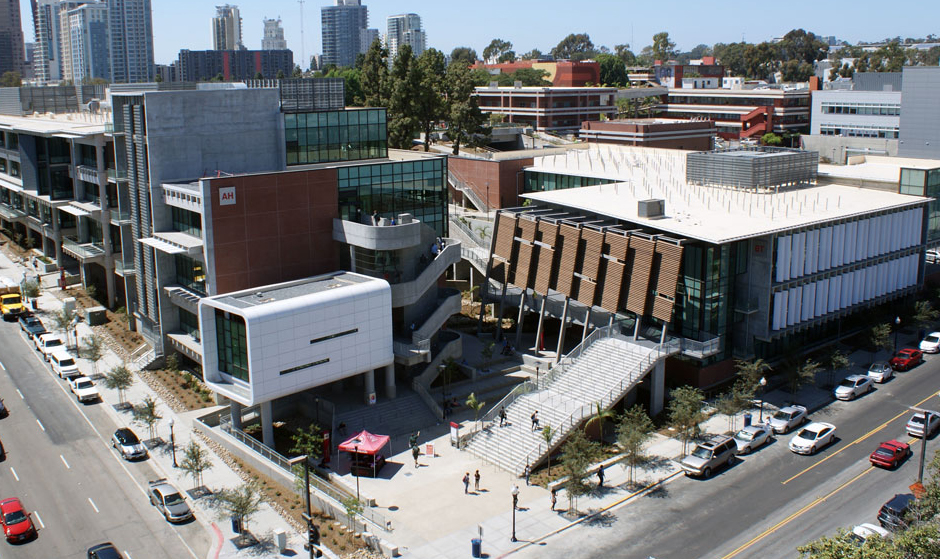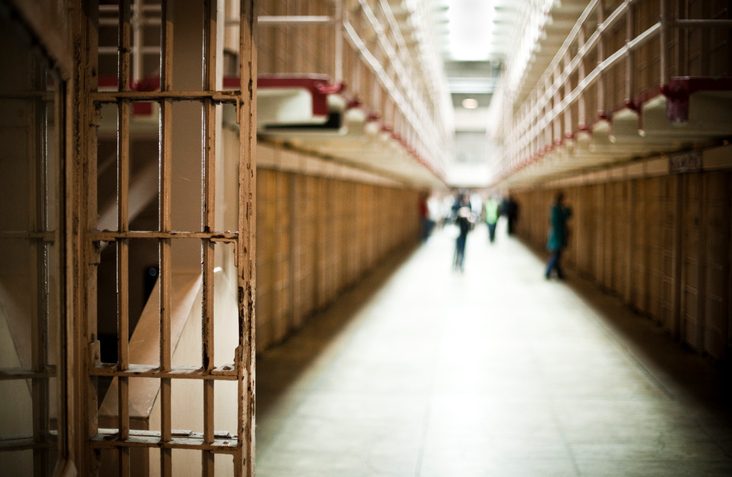Daily Business Report-Jan. 29, 2018
Of some 36,000 state inmates released in the most recent year for which state data is available, 46 percent were convicted of crimes again within three years.
California Increasing Rehab Efforts
to Keep Ex-Inmates Out of Prison
By Sophia Bollag | CALmatters
Gov. Jerry Brown wants to add millions in new spending on programs to help former inmates stay out of jail—a proposal generating bipartisan praise because of concern they are returning to prison in large numbers. But some say it still isn’t enough.
The proposed $50 million would expand job training for prisoners and assist them in finding jobs once they are released, such as training them to become firefighters.
The governor’s budget plan also includes $106 million for an existing incentive program that rewards counties for reducing recidivism.
Many supporters say California must invest more to ensure the state’s criminal justice overhaul—which reduced state prison

overcrowding by transferring low-level offenders to county jails and local supervision—achieves its goal of keeping ex-inmates from returning to prison.
“The old way of locking people up and throwing away the key clearly hasn’t worked. It’s just led to a lot of costs but not a lot of results,” said Assemblyman Phil Ting, a San Francisco Democrat who chairs the Assembly’s budget committee. But he wants to see more money spent on efforts to prevent people who’ve served their time from committing crimes again, although he declined to give a specific amount.
“What we would love to see this year is perhaps a longer-term investment that may actually help reduce the population because they’re not recidivating anymore,” he said. “It’s an area that we’ve talked a lot about, but I don’t think that we’ve done enough or taken a harder look at what’s working and what’s not working.”
Perhaps the most troubling evidence of what’s not working: Of some 36,000 state inmates released in the most recent year for which state data is available, 46 percent were convicted of crimes again within three years.
“That’s a very miserable number. It indicates that the efforts, as currently constituted, are not being as successful as they need to be,” said Assemblyman Tom Lackey, a Palmdale Republican. He said he was happy to see the governor proposing new spending on anti-recidivism efforts, but plans to introduce legislation to audit rehabilitation programs to determine which are successful.

Experts say it’s difficult to directly compare recidivism rates among states, but California’s rate is considered high, said Mia Bird, a research fellow at the nonpartisan Public Policy Institute of California. California’s state prison population is about 130,000. The state’s incarceration rate had been higher than the national average in the past, but it has fallen sharply: Last year California had 334 state inmates for every 100,000 residents.
Part of that dramatic decline was driven by a policy known as realignment, which after 2011 assigned the responsibility for new offenders determined to be less serious from state prisons to local jails or back into the community under supervision. Lawmakers made that major switch in 2011 after federal courts ruled California prisons were too overcrowded to provide inmates adequate health care.
Supporters promoted realignment as a way to keep former inmates from reoffending by shifting more responsibility to county officials, who theoretically would understand better than the state what programs their communities need.
But a recent study by Bird and her colleagues found realignment had mixed effects.
“Recidivism rates didn’t change much after realignment, so everyone can breathe a sigh of relief that they didn’t go up dramatically,” Bird said. But she acknowledged that recidivism levels are still high and have been for a long time. “In the short run, we might need to spend a bit more money in order to have some long-run gains.”
After realignment kicked in, voters approved two initiatives to further lower incarceration rates by reducing punishment for low-level offenders: Proposition 47 in 2014 and Proposition 57 in 2016. But neither realignment nor the other changes have resulted in the crime reductions or savings supporters promised, said Sacramento County District Attorney Anne Marie Schubert.
Prop. 47, which lessened penalties for lower-level crimes, including some types of theft and illegal drug use, “wreaked havoc” in California, she said, citing what she described as “rampant” and underreported retail theft as evidence the punishments under the law are too lenient to deter crime.
And although realignment successfully reduced the state prison population, it also placed new strain on counties. They’ve received several billion dollars to cover the increased costs to house and supervise more people, but critics say it still isn’t enough to fund needed rehabilitative services.
“We need more resources,” Schubert said. “It’s not a cheap process to help get people back on track, but we have to be willing to invest.”
Brown proposes to spend about $12 billion—9 percent of the state’s general fund—for the Department of Corrections and Rehabilitation in the fiscal year that begins in July.
The budget includes more than $130 million to fix roofs, remove mold and update other aspects of aging infrastructure.
Although it’s important for prison facilities to be maintained, money could be better spent on services for former inmates after they leave prison, said John Bauters of Californians for Safety and Justice, a group that advocates for criminal justice reform. The governor’s budget doesn’t make any “dramatic” changes to money spent on rehabilitation programs for inmates, which need to be matched by programs to help people when they re-enter society, Bauters said.
“We’ve got so much money that is being spent right now on prison programs and the reality is that if we actually invest in proven prevention methods and rehabilitative programs, we won’t have the same need to spend that kind of money in the future,” he said.
Assemblyman Reggie Jones-Sawyer, who chairs the Assembly Public Safety Committee, also is advocating greater accountability—saying he’ll request a review of rehabilitation programs to ensure the state is investing in ones that work. The Los Angeles Democrat praised the investment in community incentives to lower recidivism rates, saying “I think it’s definitely going to be one of his legacy pieces.”
Prison reform has been a key goal of Brown’s throughout his current term as governor. He championed realignment and Proposition 57, which expands the portion of inmates eligible for parole.
“He’s been telling me for years that he really, really wanted to work on the overcrowding in our prisons,” Jones-Sawyer said. “He really felt for California to have one of the highest incarceration rates in the country, it really bothered him.”
Some have criticized Brown’s approach policies as too soft on crime. Sen. Jeff Stone blames realignment and other policy changes for what he characterizes as high crime rates in the state. “We are letting too many people out of jail and we aren’t putting enough people in jail or prison,” the Temecula Republican said. “We’re not holding people accountable for their crimes.”
Between now and June, Brown and Democrats who run the Legislature will negotiate a final budget deal. Although the state is expecting a $6 billion surplus this year, Brown has repeated his usual caution to Democratic lawmakers, who typically push for more spending, to save much of that money for a future recession.
But Ting says he sees a key opportunity this year to invest in efforts to stop recidivism. It’s Brown’s final year in office and therefore his last chance to solidify the criminal justice policy changes he oversaw.
“Our hope is that we can find significant common ground in this area,” Ting said. “We want to ensure that every individual who’s in the system, we’re doing everything possible to work with them so they don’t come back.”
Sophia Bollag is a contributing writer to CALmatters.org, a nonprofit, nonpartisan media venture explaining California policies and politics.
___________________
Qualcomm to Appeal Massive
Fine Levied by European Union
RCR Wireless News
The European Union Commissioner of Competition Margrethe Vestager last week announced a $1.2 billion fine against chipmaker Qualcomm, alleging the U.S. company influenced consumer choice through an exclusivity arrangement with Apple. Qualcomm has said it will appeal the decision.
Qualcomm Executive Vice President and General Counsel Don Rosenberg said he’s “confident this agreement did not violate EU competition rules or adversely affect market competition or European consumers. We have a strong case for judicial review and we will immediately commence that process.”
___________________
UC San Diego Among 12 Nationwide to Pilot
Apple Inc. New Medical Records Access System
San Diego Union-Tribune
UC San Diego patients will be among the first in the nation to test an iPhone-based medical records access system now under development by Apple Inc. The Cupertino-based technology company announced that it has selected a dozen health systems from coast to coast to pilot automatic synchronization of patient data, from test results to medications prescribed, within a health application that Apple has been including with every iPhone since 2014. For now, only those UC San Diego iPhone owners brave enough to load the new 11.3 “beta” version of iOS, the system software that runs all iPhones, will be able to try out the new medical records integration, which will appear as a “health records” section within the pre-existing Health app.
___________________
Ernest and Evelyn Rady to Announce
$50 Million Donation to Aid the Homeless
Philanthropists Ernest and Evelyn Rady will announce a $50 million donation to The Salvation Army today to help finance an $80 million capital campaign to build two new facilities for the homeless. The private event will be at the Door of Hope.
The project will be completed in two major phases, starting with The Rady Residence at the Door of Hope. The Rady Center will be built Downtown after The Salvation Army raises the additional $30 million to complete the campaign.
The Salvation Army Rady Center will serve single men in Downtown San Diego, and The Salvation Army Rady Residence at The Door of Hope will help two-parent families for the first time, in addition to the single mothers and children, single women, and women in recovery who currently live and participate in programs at The Door of Hope.
“We have great confidence in this organization, so we are happy to put our resources in their hands, and we look forward to a successful conclusion,” said Ernest Rady. “I’m really proud of what we’re doing.”
The donation goes on record as one of the largest charitable gifts ever given to support homelessness and is the third largest donation in The Salvation Army’s 153-year history.
“The center will serve as a new standard for effective programs and housing for homeless across the United States,” said Major George Baker, Salvation Army divisional commander.
___________________
Cushman & Wakefield Report:
San Diego Retail Market Thrives
Cushman & Wakefield’s new retail market report revealed another thriving year in the retail sector, driven by continued declining vacancy and significant occupancy growth, particularly in the year’s second half. Fueled by continued strong economic conditions and favorable demographics, San Diego maintains its place as a premier market for current and expanding retailers, according to the report.
The firm’s new report showed that overall retail vacancy in San Diego fell to a mark of 4.1 percent by the end of 2017, shedding 30 basis points from mid-year 2017 and 40 basis points from a year ago. Current vacancy is now more than 300 basis points below its peak rate of 7.2 percent recorded eight years ago at the end of recession. Meanwhile, occupancy grew by nearly 210,000 square feet across all center types in the second half of 2017, lifting annual net absorption to nearly 270,000 square feet for year 2017.
“San Diego’s retail market maintains steady occupancy driven by continued strong employment and overall economic growth,” said Jolanta Campion, Cushman & Wakefield’s research director in San Diego.
___________________

Future USS Omaha to be Commissioned
Feb. 3 at Downtown’s Broadway Pier
The Navy’s newest Independence-variant littoral combat ship, the future USS Omaha (LCS 12) will be commissioned at noon on Saturday, Feb. 3 at Downtown San Diego’s Broadway Pier. USS Omaha will be homeported at Naval Base San Diego.
Former Nebraska senator and Medal of Honor recipient Joseph Robert “Bob” Kerrey will deliver the commissioning ceremony’s principal address. Philanthropist Susie Buffett will serve as sponsor of the ship. The ceremony will be highlighted by a time-honored Navy tradition when Buffett will give the first order to “man our ship and bring her to life!”
Cmdr. Michael Toth, a native of North Ridgeville, Ohio is the commanding officer of the ship and leads the core crew of 70 officers and enlisted personnel. The 2,300-ton Omaha was built by Austal USA shipyard in Mobile, Ala. The ship is 418 feet in length, has a beam of 104 feet, and a navigational draft of 14 feet. The ship is powered by two gas turbine engines, two main propulsion diesel engines, and four waterjets to speeds up to 40-plus knots.
LCS 12 is the eleventh littoral combat ship to enter the fleet and the sixth of the Independence variant. It will be the fourth ship to be named for Omaha, the largest city in Nebraska.
___________________

New Cybersecurity Programs
Approved at San Diego City College
With demand for skilled computer information technicians soaring both in the region and around the country, City College is in the midst of vastly expanding its cybersecurity programs to include an Associate of Science Degree in Cybersecurity, a Certificate of Achievement in Cybersecurity, and a Certificate of Performance in Cyber Incident Response.
The average pay of an information security analyst in San Diego County was nearly $100,000 per year as recently as May of 2016, according to the federal Bureau of Labor Statistics and employment in the industry is projected to grow by 28 percent in the 10-year period ending in 2026. While most of professionals earning that kind of money have a bachelor’s degree or beyond, the median annual salary for those with a certificate in computer networking from a California community college exceeds $53,000 just two years after securing the certificate, and nearly $60,000 just five years after securing the certificate, according to the California Community Colleges Chancellor’s Office.
City College estimates nearly 24,000 people were employed in the cybersecurity program area in 2016, with more than 700 new job openings projected over the next five years.
The spring semester begins at City, Mesa, and Miramar colleges today. For class schedules and to enroll, visit www.sdccd.edu/imagine.
___________________
Maggie Schroedter Elected President
of San Diego Bankruptcy Forum

Maggie Schroedter, business litigation and bankruptcy attorney with Higgs Fletcher & Mack, has been elected 2018 president of the San Diego Bankruptcy Forum. Schroedter served on the board of directors and has been a member of the San Diego Bankruptcy Forum for three years prior to being elected in January.
The San Diego Bankruptcy Forum, an affiliate of the California Bankruptcy Forum, is a 501(c)(3) organization whose mission is to provide educational support, a structure for communication between the San Diego bankruptcy bar and the bench, as well as networking opportunities for its members.
In addition to her recent leadership role, Schroedter serves as Newsletter Editor for Lawyers Club of San Diego, the largest specialty bar association in San Diego. In 2017, Super Lawyers honored her as a “Rising Star,” distinguishing her as a top rated bankruptcy attorney in San Diego.
Schroedter specializes in commercial litigation, with special emphasis on business disputes, business reorganization, and other insolvency matters, including Chapter 11.
Schroedter received her Bachelor’s of Science degree from the University of Florida where she was on the Dean’s List. At Boston University School of Law, she was a Public Interest Law Journal member.




